African History through the Lens of Economics: An introduction to African development and history
The Wheeler Institute’s open access online course, African History through the Lens of Economics, covered pre-colonial political organisation and contemporary social structures in two lectures, the first by Stelios Michalopoulos, Eastman Professor of Political Economy at Brown University, and Warren Whatley, professor emeritus of economics at the University of Michigan, the second by Nathan Nunn, Frederic E. Abbe Professor of Economics at Harvard University, facilitated respectively by Dr Alfred Tembo, Lecturer in African History at the University of Zambia, and Chinemelu Okafor, doctoral student and Graduate Prize Fellow at Harvard University’s Government Department.
Investigating the economic importance of political organisation
Professor Michalopoulos’s lecture reviewed the development of a research agenda over the past few years that has looked at how political institutions shape African economic performance. It is well established that stronger national institutions are correlated with better economic outcomes but trying to move beyond correlation has been a circuitous journey.
Michalopoulos’s starting point was to overlay contemporary national boundaries onto the ethnic homelands mapped in George Murdock’s Africa: Its peoples and their culture history (1959) and Ethnographic Atlas (1967). The Berlin Conference of 1885 involved the drawing of boundaries for protectorates, free-trade areas and spheres of influence that cut across pre-existing ethic groupings and that persist into the current period. This represents a historical natural experiment, allowing economists to investigate the development paths for the same ethnic groups in countries with different institutional structures. 220 of the 826 ethnic groups in Murdock’s map were split across national boundaries in this way. To measure development, Michalopoulos was able to use luminosity as recorded at high levels of granularity in satellite imagery.
Initial research did not yield the expected discontinuities at the border, so further nuance was required. Inspired by Jeffrey Herbst’s States and Power in Africa: Comparative Lessons in Authority and Control (2000), researchers began to consider the differences between hinterland and urban centres and the low level of penetration of national political structures outside capital cities. This new approach showed that where ethnic groups are split across borders and where they are near their respective capital cities, strength of national institutions was much more predictive of economic performance.
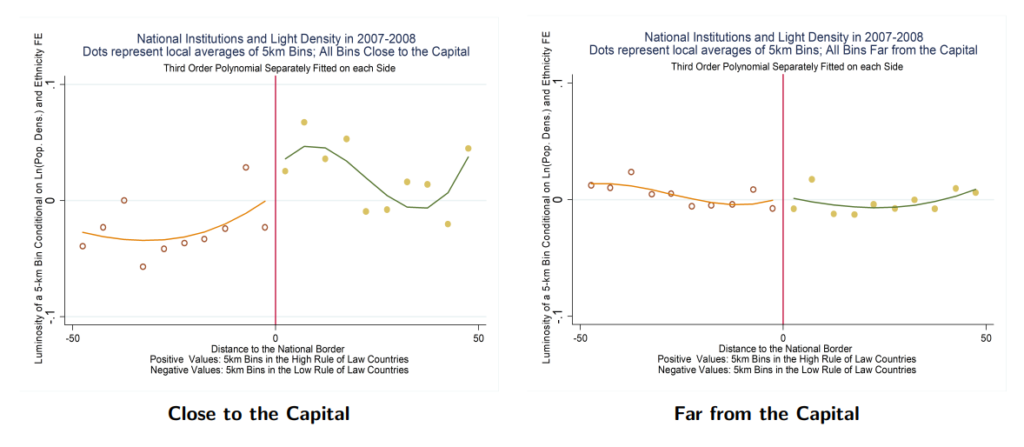
A natural next channel of research was into the factors affecting economic development in the hinterlands, where national institutions were less embedded. There was heterogeneity in local structures during the colonial period but it was common to see indirect rule through pre-colonial institutions. These institutions themselves displayed a large variation in the degree of centralisation, ranging from centralised kingdoms such as the Zulu and Buganda, through large chiefdoms such as the Wolof and Ashanti, to locally acephalous arrangements, for example the Nuer in Sudan. Early anthropological studies, notably Fortes and Evans-Pritchard (1940) categorised pre-colonial systems based on whether power was held by a centralised authority or not. Such a distinction was used in the seminal work of Mary Douglas, Lele economy compared with Bushong (1962), in which the Bushong’s origins in the Kuba kingdom under Shyaam are deemed relevant to their economic outperformance.
Michalopoulos verified that traditional leaders remain influential in African societies by using Afrobarometer results from the 2008 survey round. He and his co-researchers then identified centralised states, again using Murdock’s Ethnographic Atlas (1967) – specifically the analysis of “Jurisdictional Hierarchy above the Local Community Level”, on a scale of 0 to 4.
The investigation could then be refined to look at within-country boundaries between societies which in pre-colonial times were centralised and those which were acephalous. There is an improved economic performance associated with centralised structures. There are several channels through which this effect could have been brought about, including increased pacification under centralised societies, greater accountability for chiefs and co-operation across villages, greater concessions from colonisers, and better respect for property rights.
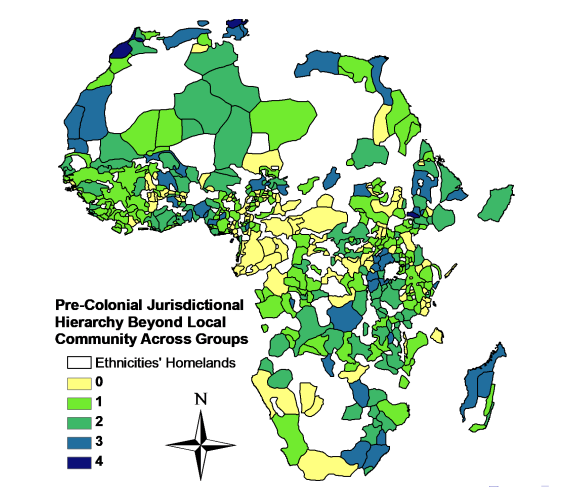
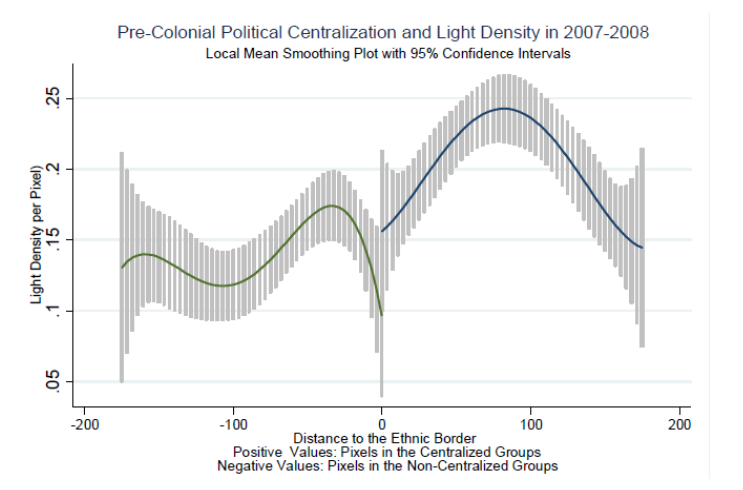
More recent scholarship has advanced this research agenda. For example, Depetris-Chauvin (2016) looked at improving the classification of pre-colonial statehood, taking account of 1,000 years of historical record, and generated a State History Index, which was used to show that previously centralised states have experienced less conflict over the last 40 years. Wilfhart (2018) conducted 350 interviews with local people in Senegal, which has seen significant political decentralisation since 1996, and looked at archival records to determine more precisely the characteristics of late 19th century states. She finds that where early states existed, present-day administrations raise more taxes, have fewer difficulties with projects, fewer allegations of inequality, and greater belief that decentralisation is an improvement.
The key message from this presentation was that there exists a dual institutional framework across many regions and that the quality of relationships between local actors and national governments seems to be affected by the historical legacies of the groups. There is a lot of exciting research into the mechanisms through which these effects are produced and into exploring the heterogeneity of structures and outcomes. Michalopoulos closed with an appeal for more inter-disciplinary work to generate a more nuanced set of variables for future analysis.
What economists know about pre-colonial political centralisation in Africa
Professor Whatley’s lecture then took a slightly different perspective, by focusing on the concept of pre-colonial political centralisation, its meaning, correlation and causes. He acknowledged the importance of state centralisation to studies of economic development globally and the persistent correlation between pre-colonial political structures and levels of income and public goods, and then laid out some current research into the emergence of centralisation.
As discussed in the preceding section, centralisation is usually taken as a variable from Murdock’s Ethnographic Atlas, which itself is derived from Swanson’s analysis of ‘sovereign organisations’ in The Birth of the Gods (1960). Whatley made two points about this. First, centralisation may not be best represented by sovereignty, as seen in Europe where centralisation is believed to have emerged from weak rather than strong monarchies. Second, pre-colonial centralisation is itself an outcome of a prior history that is poorly understood by economists. Whatley noted, for example, that there is little correlation between early major cities such as those recorded in Chandler and Fox, 3000 Years of Urban Growth (1974), and Murdock’s measures of centralisation. This should act as a prompt for further research in the area.
Whatley then introduced some of his own current research – to be published in How the International Slave Trades Underdeveloped Africa in the Journal of Economic History in 2022 – into how societies across the continent responded to slave capture and trading. He investigates the relationships between travel time to the nearest slave ports in both the trans-Saharan and trans-Atlantic trades and the spread of inter-related bundles of institutions and rights, one of which is political centralisation.
Under an assumption that the capture of slaves generated wealth for societies closer to the ports, Whatley investigates to what extent societies had institutions such as slavery, polygyny, family-based wealth, aristocratic land ownership and centralisation. He finds that across all of Africa, exposure to slave trading increased the likelihood of slavery being present in the society and the likelihood of slavery and polygyny together. He also finds that proximity to trans-Saharan slave ports reduced centralisation, especially in West Africa, but that there was no systematic effect on centralisation from proximity to Indian and Atlantic Ocean slaving routes. In terms of bundled institutions, he finds that in East Africa polygynous, family-based slavery increases in likelihood with proximity to a port, while in West Africa politically-centralised, aristocratic, family-based, polygynous slavery similarly increases in likelihood with proximity to a port. In other words, centralisation may have emerged partly from involvement with slave trading, often in association with other social structures.
Whatley extends his analysis to consider the effect of exposure to slave capture on the spread of the institution, finding that centralised states were relatively likely to have slaves irrespective of their distance to a slave port, while decentralised states see an increase in the likelihood of having slavery with greater exposure to the practice, but at lower levels than centralised states.
Some of Whatley’s main conclusions from his analysis are that centralisation means something different in different regions of Africa, that centralisation is often associated with slavery, and that centralisation in West Africa is closely tied to slavery, polygyny, inheritance patterns and landed aristocratic control. He closed by emphasising that the slave trades actually made European and African societies more different, moving African societies towards slavery, polygamy, decentralisation, aristocracy, matriliny, ethnic stratification and underdevelopment, as outlined in his forthcoming book, The Making of the Other: How Black Africa Became the Mirror Image of White Europe.
Understanding social structures in African societies
Professor Nunn’s lecture picked up these themes by focusing not on state centralisation – ‘the levels of political authority beyond the local community’ – but on other important social structures that take a corporate form, ‘determining rights, obligations, use rights over land for different groups.’ He highlighted on three main types of social structure and the relevant dimensions of each:
- Family structure – encompassing, for example, marriage types (polygamous or monogamous), nuclear or extended groupings, and matri-/patrilocality or neolocalilty.
- Kinship and lineage organisation – for example, in matri-/patrilineal or cognatic descent, and segmented lineages.
- Age-based organisation – for example, in age sets and age grades.
Nunn reiterated the institutional consequences of social structures, as outlined in Emmanuel Todd’s The Explanation of Ideology (1985), which posits that state structures, for example communism, can be traced back to social structures, for example those with high levels of authority and equality.
The WEIRD Western perspective of African societies
Before reviewing in detail some of the work on African social structures, Nunn introduced the concept, developed by Henrich, Heine and Norenzayan (2010) and Jones (2010) that the West is unusual from a global perspective in having a bundle of beliefs, customs and institutions that are characterised by being Western, Educated, Industrialised, Rich and Democratic. For example, on the questions from the World Values Survey of whether it is a duty towards society to have children or whether a woman has to have children in order to be fulfilled, African societies are more typical of global beliefs and the U.S. is an outlier.
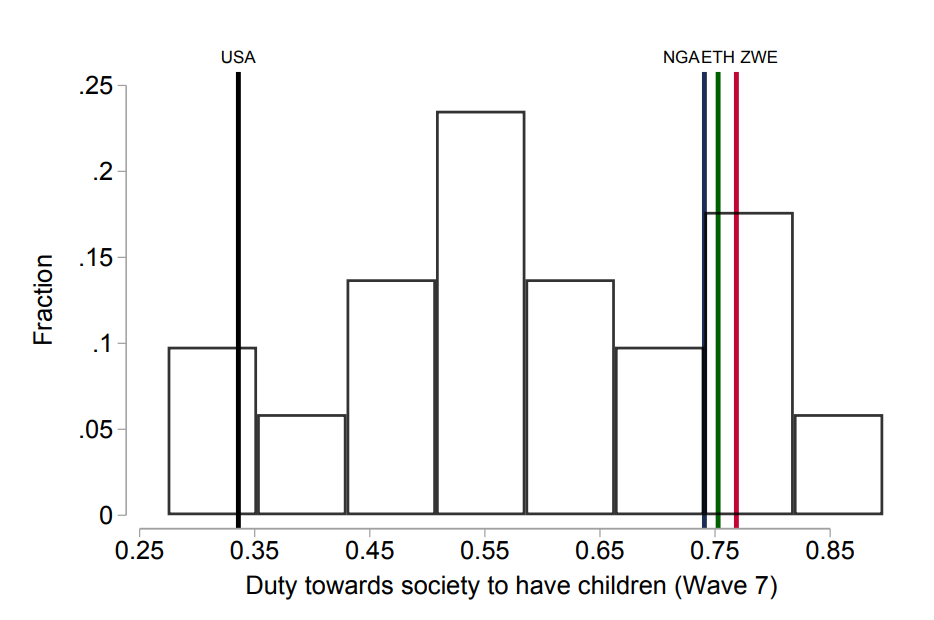
Nunn’s research uses the Ethnologue, a contemporary atlas of over 7,000 languages and dialects to connect people to their ancestors. It links contemporary societies to the Ethnographic Atlas, a database of 1,300 ethnic groups, with information about their characteristics. For instance, one can link the Portuguese ethnic group to contemporary Portuguese speakers. Then, taking an average of individuals within a country, you can calculate a fraction of individuals within a country (belonging to a particular language group) that had ancestors displaying a particular trait. Nunn has built up pictures of, for example, the proportion of global populations with ancestors that had independent nuclear families or a preference for cousin marriage.
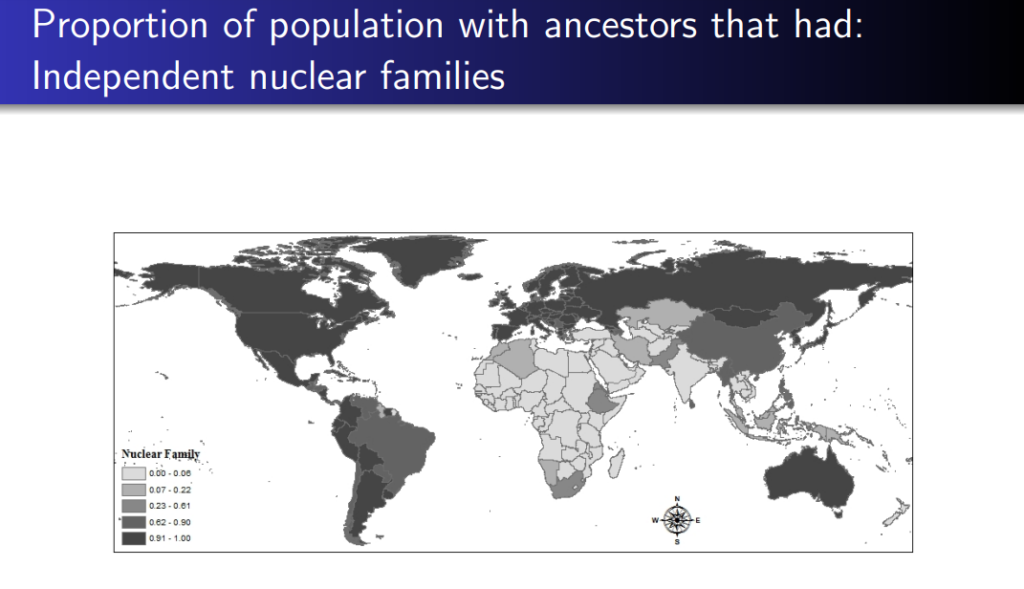
What can be seen is that Western Europe – and its colonies in North and South America and Australasia – is unusual and relatively uniform. Henrich’s theory, building on Goody (1983), is that beginning in the early Modern period, the Church deliberately weakened traditional lineage systems. Enke (2019) has correlated kinship tightness and economic development, represented by population density or urbanisation rates, over time, finding stronger, negative correlations from 1900 onwards.
Two examples of Western misunderstandings
Nunn concluded with two examples of Western misunderstanding and misrepresentation of traditional practices, namely matrilineal kinship and bride price.
In the early years of the twentieth century, anthropologists were puzzled by matrilineal kinship, whereby children are related to their mother and their mother’s family, rather than to their father’s lineage. This appeared to create conflicting allegiances, with children closer to maternal uncles than fathers. There are some possible reasons for its existence, such as certainty of relationship and multiple male allegiances in case of disappearance (for example, through slave capture), and the practice is particularly common in the ‘matrilineal belt’ across sub-Saharan Africa.
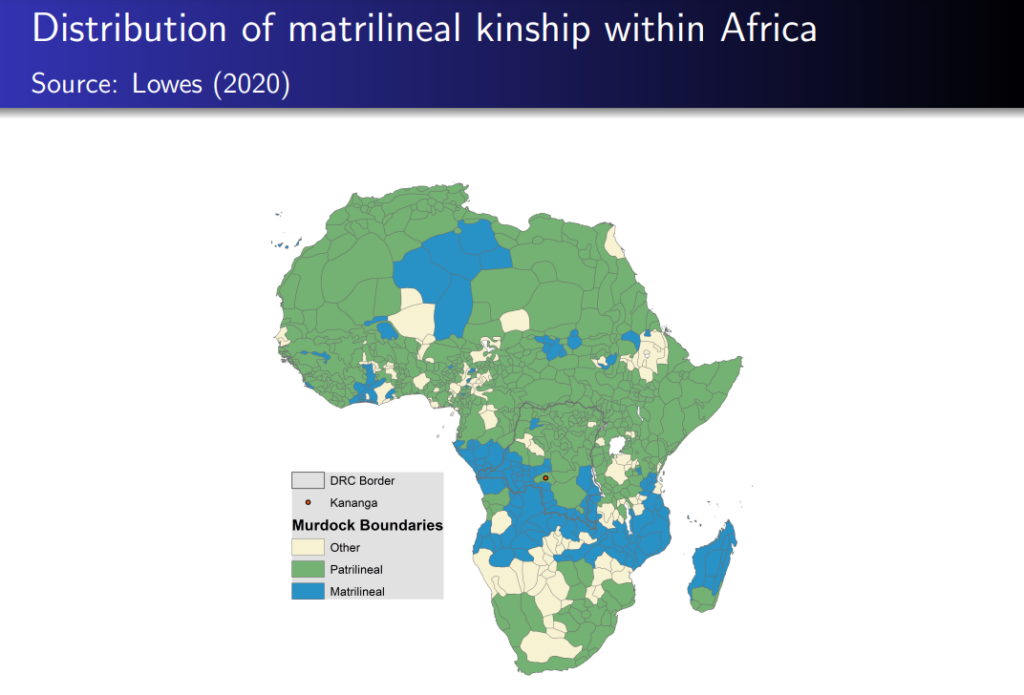
Lowes (2020) studied the system in Kananga in the Kasai region in the DRC, taking data from DHS surveys (USAID’s Demographic and Health Survey Program) and her own interviews from the region. She found that matrilineal kinship is associated with children that are healthier and better educated, wives that are more empowered and less accepting of violence, households with less domestic violence and households with less co-operation between husbands and wives (determined by using a public goods game where husband and wife make independent decisions about how much to contribute to a communal, household pot). In general, therefore, the practice is associated with better, rather than worse outcomes, contrary to previous expectations.
A second practice, subject to misunderstanding and misinterpretation, is the transfer of resources from the groom to a bride’s parents at the time of marriage. Early anthropologists again assumed this was a purchase and hence called it a ‘bride price’. Starting with Bernhard Vroklage, however, it was reinterpreted as a gift of appreciation for ‘the care and trouble spent on the bride’s upbringing’ and ‘not a humiliating thing at all, on the contrary… something rather honourable.’
Nunn et al. (2020) looked at the consequences of the practice in Indonesia and Zambia, both countries where there is some regional variance in prevalence and large school construction programmes. They found that school construction had zero average effect on girls’ education, but that this effect masked heterogeneity; in regions with a bride price, girls’ education increased. One reason for this, confirmed in a survey from the Lusaka region, is that education is an important factor in determining the bride price. Lowes and Nunn (2014) studied the value (rather than the existence) of the bride price, finding that a higher bride price is associated with wives being less accepting of domestic violence, wives reporting higher levels of self-reported happiness, and more cooperative/cohesive marriages.
Exciting areas for future research
Taken together, these two lectures highlighted the many areas in which recent research has advanced on notions of political organisation and social structures to provide a more nuanced understanding of how they are related to economic development and wellbeing. Professor Michalopoulos emphasised the heterogeneity that is being explored across and within countries around how institutions shape outcomes. Professor Whatley showed that the independent variables in such analyses are themselves interesting objects of research and the product of complex historical interactions. Finally, Professor Nunn emphasised the need to understand that, in the words of Professor Ehret in the first lecture in the series, ‘where you stand matters’ and that Western academics must be aware of their own biases when interrogating African social structures.
African History through the Lens of Economics is an open-access, interdisciplinary lecture series to study the impact of Africa’s history on contemporary development by the Wheeler Institute for Business and Development. This course is led by Elias Papaioannou (London Business School), Leonard Wantchekon (Princeton University), Stelios Michalopoulos (Brown University), and Nathan Nunn (Harvard University and supported by CEPR, STEG and the European Research Council. The course ran from February 1 to April 13 of 2022 and has attracted more than 27.000 registrations. For more information visit the course website.
David Jones (MBA 2022) is a Classics graduate and has worked as a teacher in Malawi, an accountant at Deloitte and in the finance function at the Science Museum in London. He completed an internship with the Wheeler Institute’s Development Impact Platform in Zambia over summer 2021 and is now continuing as an intern for the Wheeler Institute, contributing to the creation of content that amplifies the role of business in improving lives.
